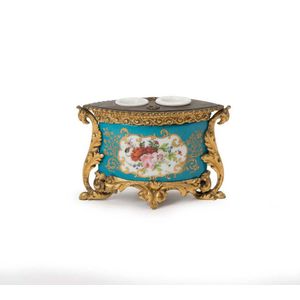Victorian Silver Cruet Set in Original Case
You must be a subscriber, and be logged in to view price and dealer details.
Subscribe Now to view actual auction price for this item
When you subscribe, you have the option of setting the currency in which to display prices to $Au, $US, $NZ or Stg.
- Sterling Silver - Sterling silver is a mixture of 92.5% pure silver and 7.5% of another metal, usually copper. Fine silver is 99.9% pure silver, and is relatively soft and the addition of the very small amount of copper gives the metal enough strength and hardness to be worked into jewellery, decorative and household objects.
- Crimped - A wavy effect on the the rims or lips of glass or silver vessels. Crimping was frequently used on brightly coloured Victorian glass.
- Marrow Spoon - A spoon with a long handle and a narrow scoop shaped bowl, used to scoop and eat marrow from the hollow centre of roasted bones. Some marrow scoops are double ended with a different shaped bowl at each end.
- Victorian Period - The Victorian period of furniture and decorative arts design covers the reign of Queen Victoria from 1837 to 1901. There was not one dominant style of furniture in the Victorian period. Designers used and modified many historical styles such as Gothic, Tudor, Elizabethan, English Rococo, Neoclassical and others, although use of some styles, such as English Rococo and Gothic tended to dominate the furniture manufacture of the period.
The Victorian period was preceded by the Regency and William IV periods, and followed by the Edwardian period, named for Edward VII (1841 ? 1910) who was King of the United Kingdom and the British Dominions and Emperor of India for the brief period from 1901 until his death in 1910.
This item has been included into following indexes:
Visually similar items

A Chinese cloisonne tripod censer, a censer of compressed form with a pierced dome lid surmounted by a recumbent qilin, addorsed twin lion handles and raised on cabriole lion's paw feet with figural mounts, decorated with flowers and scrolling forms in col

A pair of 19th century French cast gilt metal candlesticks, each with shaped foot and moulded standard above a blue porcelain baluster form with garlands, and foliate scrolled branches approx. 50 cm high

A Sevres style gilt metal mounted bleu celeste navette shaped ink well, 19th century, 8 cm high

A massive George III embossed sterling silver soup tureen, London 1818, with maker's mark for John & Henry Lias, of compressed rectangular form with a conforming lid and cast ring handle, profusely embossed and chased throughout with flora upon a textured
